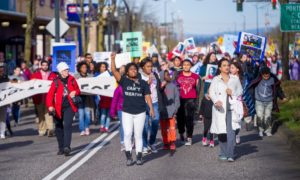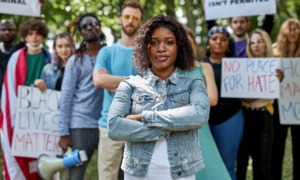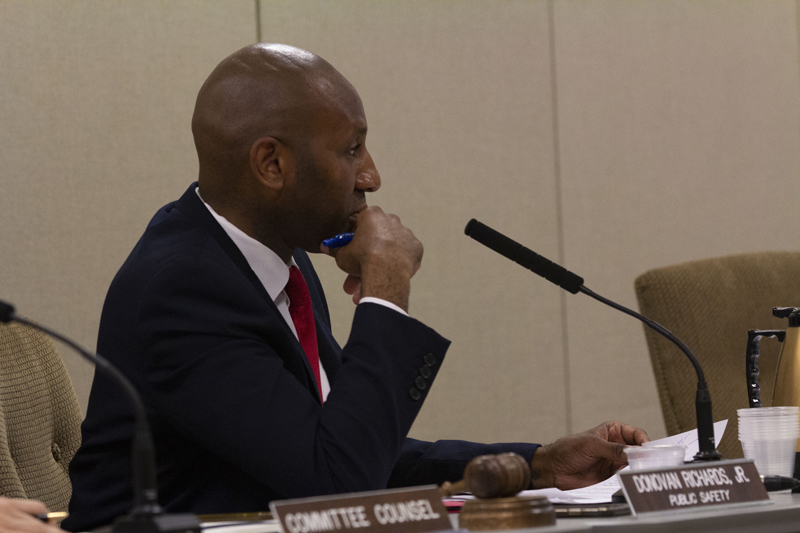
Photos by Niamh McDonnell
Council Member Donovan Richards chaired a public hearing for the New York City Council Committee on Public Safety meeting on his bill, which would tweak the gang database.
NEW YORK — In the early morning hours of April 27, 2016, Kraig Lewis was up late studying for his statistics final. A graduate student at the University of Bridgeport in Connecticut with only nine credits left until completing his MBA, Lewis planned to go to law school next. At about 4 a.m., Bridgeport Police banged on his door.
When Lewis opened it, they rushed in with a warrant. “When I looked at the warrant it said racketeering, narcs on the playground, guns,” he said. “And I’m like ‘what?’” Hanging on Lewis’ wall was a “Stop the Violence” poster — a photo he had taken with DJ Self of Power 105.1, a New York City radio station.
 At the time, Lewis had been involved with the Stop the Violence campaign, going from school to school in Bridgeport trying to influence kids and prevent gang involvement. Now, the New York Police Department was accusing him of the exact things he had been working hard to combat.
At the time, Lewis had been involved with the Stop the Violence campaign, going from school to school in Bridgeport trying to influence kids and prevent gang involvement. Now, the New York Police Department was accusing him of the exact things he had been working hard to combat.
Lewis was indicted and eventually convicted on felony charges. Plans for the future had to be put on hold, some permanently. “I’m talking graduation, law school, all my events, my son, everything taken from me,” he said. “Everything. And I was a school kid. Never been to jail.”
Lewis would spend roughly the next two years in prison, along with dozens of others in what’s known as the Bronx 120 — a police gang raid that resulted in erroneous allegations and arrests for many. Now Lewis is loaning his voice to activist advocating for other black men in positions like his.
He challenged the existence of the NYPD’s gang database at a City Council hearing Thursday on a bill that would notify minors who are added to the database and allow them to appeal their presence. The bill is sponsored by Council Member Donovan Richards, a Queens Democrat.
Disagreement over effects of bill
Proponents claim this measure would help with investigating violent crimes and “precision policing,” a term used to describe new, digital techniques in law enforcement. Opponents say the problem lies with the database itself and that this provision would only further entrench its use as a surveillance tool for people of color.
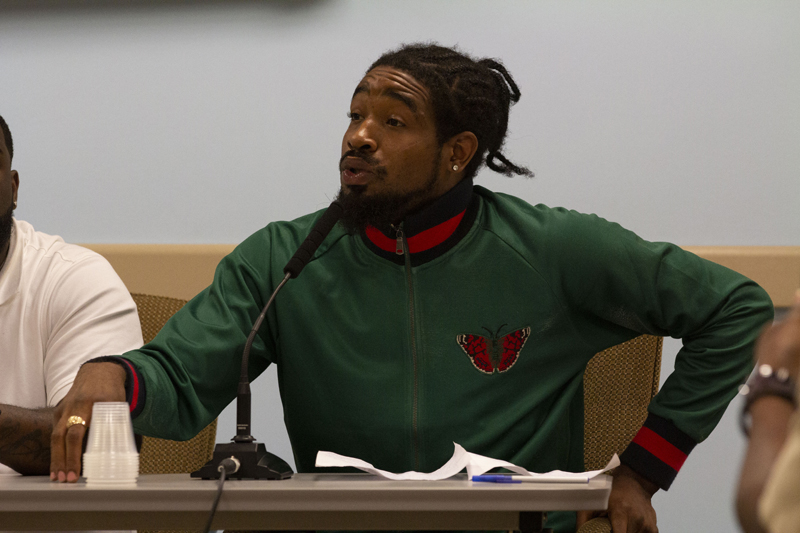
Kraig Lewis, who was swept up in the Bronx 120 gang raid in 2016, testifies at the hearing on the gang database bill.
For Richards, the bill would chip away at the database’s existence and influence. “This bill represents a small but crucial first step to achieving transparency and oversight of a law enforcement tool that raises a lot of concerns about policing and racial equity in this city,” he said.
The executive director of legislative affairs for the NYPD, Oleg Chernyavsky, said the intelligence within the database stays within the department. “Information is not shared with NYCHA [the New York City Housing Authority] or employers conducting background checks or educational institutions,” he said. “And the department does not share this information with Immigration and Customs Enforcement.”
Opponents of the bill argued otherwise.
“As a practicing criminal defense attorney, I have seen this information being shared. It’s in the police reports,” said Yung-Mi Lee, supervising attorney at Brooklyn Defender Services. “And if you are arrested, and it appears that more than 90% of these people in the database have been arrested, it’s clearly shared with the prosecutors.”
Alex Vitale, director of the Policing & Social Justice Project at Brooklyn College, argued that the measures taken to end stop-and-frisk should apply to the gang database. “You cannot keep such a database of people who have not committed a crime,” he said. “So there’s a precedent for legislative action to just say, ‘You cannot do this.’”
Makeup of database
According to the NYPD, there are currently just over 18,000 individuals in the gang database, and 988, or 5.5% of them, are under the age of 18. The racial demographics of the database break down as:
- 66% Black
- 22.4% White and Hispanic
- 9.3% Black and Hispanic
- 1.1% White
- .5% Asian or Pacific Island
- 0% Alaskan or Native American
Even Richards acknowledges the database is flawed. In questioning its racial disparities, he asked the NYPD if well-known white supremacist gangs were included.
“Are the Proud Boys on the list?” Richards asked. “I guess the concern would be that certain communities are surveilled more than other communities.”
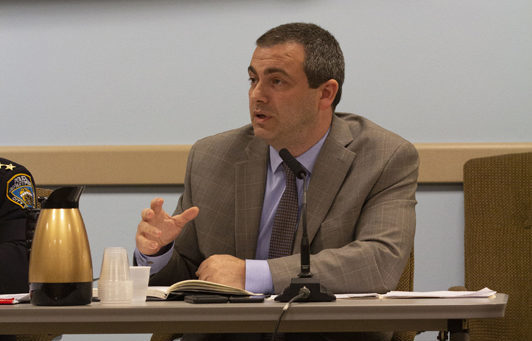
Oleg Chernyavsky, executive director of legislative affairs for the New York Police Department, said the database information is not shared.
“I can confirm that for you, I’m not 100% sure,” Chernyavsky said. “They very well may be. I’m not gonna say yes, no, but let me double-check that.”
The NYPD claims that individuals often boast about their gang membership as a status symbol. Investigators use these admissions as a justification for adding them to the list.
But an admission alone is not enough to add someone to the gang database. The NYPD weighs several factors: testimonials by police officers, social media posts, tattoos, scars, colors worn and hand gestures. Each case is then reviewed and approved by a field intelligence officer.
Despite the NYPD’s assurances, there’s still room for error. In 2016’s Bronx 120 raid (named that for the 120 names on the original indictment), half of those arrested weren’t in a gang.
‘Someone like you’
“The gang database is a stop-and-frisk 2.0,” said Vidal Guzman, a former member of The Bloods and now a community organizer for JustLeadership USA. “A lot of my friends have been caught up in the gang database. I was incarcerated with them, and I know that they feel that society gave up on them.”
Chernyavsky argued that the NYPD isn’t targeting all people of color. “Our goal is to keep that database as lean as possible, because an overpopulated database is a useless investigative tool,” he said.
Richards said he’d like to see the database abolished one day. “As a dad with a 3-year-old son, I don’t want him to be put into the database and labeled when he’s a teenager because he walked up the block with someone who may be affiliated or may not be affiliated,” he said. “The key to ensuring that young people don’t enter the system is less engagement for communities of color.”
Lewis was the last to testify at the hearing, about his own experiences with the database. “I was in grad school when they came for me and I had one more semester left to become someone like you,” he said, directing his comments to Richards.
He told the story of a young man bullied in private school. Neighborhood friends came to his defense — friends he never lost contact with. “He falls into the gang database and gets swept,” Lewis said. “Now he’s got a felony, and he can’t become you. And I say you because you’re a black man, and I wish I could be you, but I can’t now because of what they did to me.”
The bill will be amended and reintroduced at the July 23 committee meeting for another round of hearings and amendments.




